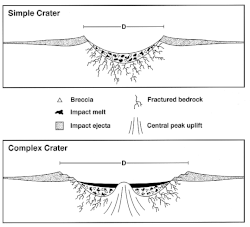Complex crater

Complex craters are a type of large impact crater morphology.
Above a certain threshold size, which varies with planetary gravity, the collapse and modification of the transient cavity is much more extensive, and the resulting structure is called a complex crater. The collapse of the transient cavity is driven by gravity, and involves both the uplift of the central region and the inward collapse of the rim. The central uplift is not the result of elastic rebound which is a process in which a material with elastic strength attempts to return to its original geometry; rather the uplift is a process in which a material with little or no strength attempts to return to a state of gravitational equilibrium.[1]
Complex craters have uplifted centers, and they have typically broad flat shallow crater floors, and
Complex craters are classified into two groups: central-peak and
Central-peak craters
A central-peak crater is the most basic form of complex crater.
A central peak crater can have a tightly spaced, ring-like arrangement of peaks, thus be a
Central-peak craters can occur in
Many central-peak craters have rims that are scalloped,
When central peaks form
Diameters of craters where complex features form depends on the strength of gravity of the celestial body they occur on. Stronger gravity, such as on Earth compared to the Moon, causes rim collapse in smaller diameter craters. Complex craters may occur at 2 kilometres (1.2 mi) to 4 kilometres (2.5 mi) on Earth, but start from 20 kilometres (12 mi) on the Moon.[5]
If lunar craters have diameters between about 20 kilometres (12 mi) to 175 kilometres (109 mi), the central peak is usually a single peak, or small group of peaks. Lunar craters of diameter greater than about 175 kilometres (109 mi) may have complex,
There are several theories as to why central peak craters form. Such craters are common, on
Height of central peak relative to crater diameter
On the Moon, heights of central peaks are directly proportional to diameters of craters, which implies that peak height varies with crater-forming energy.
See also
- Impact crater – Circular depression in a solid astronomical body formed by the impact of a smaller object
- Impact structure – Geologic structure formed from impact on a planetary surface
- Multi-ringed basin – Crater containing multiple concentric topographic rings
- Peak ring (crater)– Roughly circular ring or plateau, possibly discontinuous, surrounding an impact crater's center
- Traces of Catastrophe, 1998 book from Lunar and Planetary Institute - comprehensive reference on impact crater science
References
- ^ French, Bevan M (1998). Traces of Catastrophe: A Handbook of Shock-Metamorphic Effects in Terrestrial Meteorite Impact Structures. Houston, Texas: Lunar and Planetary Institute. pp. 120. LPI Contribution No. 954.
- ^ a b "Science Concept 6: The Moon is an Accessible Laboratory for Studying the Impact Process on Planetary Scales".
- ^ ISBN 978-1-4614-3133-6.
- ^ Bray, Veronica J (January 1, 2014). "Central peak crater". researchgate.net.
- ^ French, Bevan M (1998). Traces of Catastrophe: A Handbook of Shock-Metamorphic Effects in Terrestrial Meteorite Impact Structures. Houston, Texas: Lunar and Planetary Institute. pp. 27. LPI Contribution No. 954.
- ^ Millham, Rosemary. "Mapping The Surface of the Moon" (PDF).
- S2CID 120245830.
- ^ Hodges, Carroll Ann (1992). "Atlas of Volcanic Landforms on Mars" (PDF). pubs.usgs.gov.
- ^ Wood, Charles A. (July 24, 1973). "Moon: Central peak heights and crater origins". sciencedirect.
- Worldwide
- Africa
- Antarctica
- Asia
- Australia
- Europe
- North America
- South America
- By country
- Possible
- Acraman
- Amelia Creek
- Araguainha
- Beaverhead
- Boltysh
- Carswell
- Charlevoix
- Chesapeake Bay
- Chicxulub
- Clearwater East and West
- Gosses Bluff
- Haughton
- Kamensk
- Kara
- Karakul
- Keurusselkä
- Lappajärvi
- Logancha
- Manicouagan
- Manson
- Mistastin
- Mjølnir
- Montagnais
- Morokweng
- Nördlinger Ries
- Obolon'
- Popigai
- Presqu'île
- Puchezh-Katunki
- Rochechouart
- Saint Martin
- Shoemaker
- Siljan Ring
- Slate Islands
- Steen River
- Strangways
- Sudbury
- Tookoonooka
- Tunnunik
- Vredefort
- Woodleigh
- Yarrabubba
- Alvarez hypothesis
- Australite
- Breccia
- Coesite
- Complex crater
- Cretaceous–Paleogene boundary
- Cryptoexplosion
- Ejecta blanket
- Impact crater
- Impact structure
- Impactite
- Late Heavy Bombardment
- Lechatelierite
- Meteorite
- Moldavite
- Ordovician meteor event
- Philippinite
- Planar deformation features
- Shatter cone
- Shock metamorphism
- Shocked quartz
- Stishovite
- Suevite
- Tektite


